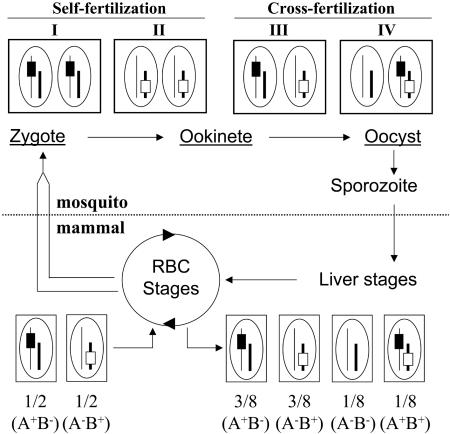Fig. 1.
Strategy for conditional mutagenesis in Plasmodium. The life cycle of Plasmodium takes place in a mammalian and a mosquito host. The haploid, RBC stages of the parasite generate gametocytes (parallel lines). In the lumen of the mosquito midgut, released gametocytes transform into gametes, which fertilize to create a zygote. Zygotes transform into ookinetes, which differentiate into oocysts. These three parasite stages (underlined) contain the two parental genomes; oocysts contain thousands of copies of the genomes generated by meiotic reduction in the diploid zygote. Sporozoites bud off from the multinucleate oocysts, traverse mosquito salivary glands, and invade mammalian hepatocytes, where they generate RBC-infecting stages. Sporozoites, liver stages, and RBC stages are uninucleate, haploid stages of the parasite. Shown around the life cycle is a parasite cross for conditional mutagenesis; boxes and ellipses indicate parasitic cells and nuclei, respectively. Two parasite clones are mixed, each carrying one marker (black or open rectangles, symbolizing a flirted sequence and the Flp-encoding locus, respectively) on distinct chromosomes (thin or thick lines, respectively). Self-fertilization propagates the parental genotypes, A+/B- and A-/B+, in type I and II cells, respectively. Cross-fertilization either regenerates the parental genotypes within type III cells or creates new, hybrid genotypes (A-/B- and A+/B+) in type IV cells. Assuming similar frequencies of self- and cross-fertilizations, as well as random chromosome segregation during meiosis in the zygotes, then 1/8 of the sporozoites, and subsequent liver and RBC stages, should contain both markers in their haploid genome.

